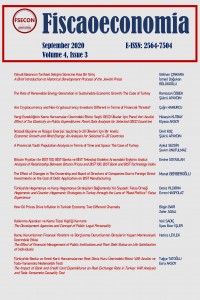Öz
Kaynakça
- Andrianto, Y., & Diputra, Y. (2017). The effect of cryptocurrency on investment portfolio effectiveness. Journal of Finance and Accounting, 5(6), 229-238.
- Butterworth, P., Rodgers, B., & Windsor, T. (2009). Financial hardship, socio-economic position and depression: Results from the PATH life survey. Social Science & Medicine, 69, 229–237.
- Chuen, D. L. K., Guo, L., & Wang, Y. (2017). Cryptocurrency: A new investment opportunity?. The Journal of Alternative Investments, 20(3), 16-40.
- Diener, E., Ng, W., Harter, J., & Arora, R. (2010). Wealth and happiness across the world: Material prosperity predicts life evaluation, whereas psychosocial prosperity predicts positive feeling. Journal of Personality and Social Psychology, 99, 52–61.
- Fiksenbaum, L., Marjanovic, Z., & Greenglass, E. (2017a). Financial threat and individuals’ willingness to change financial behavior. Review of Behavioral Finance, 9(2), 128-147.
- Fiksenbaum, L., Marjanovic, Z., Greenglass, E., & Garcia-Santos, F. (2017b). Impact of economic hardship and financial threat on suicide ideation and confusion. The Journal of Psychology, 151(5), 477-495.
- Fry, J., & Cheah, E. T. (2016). Negative bubbles and shocks in cryptocurrency markets. International Review of Financial Analysis, 47, 343-352.
- Jesus, S. N., Leal, A. R., Viseu, J. N., Valle, P., Matavelli, R. D., Pereira, J., & Greenglass, E. (2016). Coping as a moderator of the influence of economic stressors on psychological health. Análise Psicológica, 34(4), 365-376.
- Marjanovic, Z., Fiksenbaum, L., & Greenglass, E. (2018). Financial threat correlates with acute economic hardship and behavioral intentions that can improve one's personal finances and health. Journal of Behavioral And Experimental Economics, 77, 151-157.
- Marjanovic, Z., Greenglass, E. R., Fiksenbaum, L., & Bell, C. M. (2013). Psychometric evaluation of the Financial Threat Scale (FTS) in the context of the great recession. Journal of Economic Psychology, 36, 1-10.
- Marjanovic, Z., Greenglass, E. R., Fiksenbaum, L., De Witte, H., Garcia-Santos, F., Buchwald, P. & Mañas, M. A. (2015). Evaluation of the Financial Threat Scale (FTS) in four European, non-student samples. Journal of Behavioral and Experimental Economics, 55, 72-80.
- Matavelli, R. D., de Jesus, S. N., Pinto, P., & Viseu, J. (2020). Social support as a moderator of the relationship between financial threat and life satisfaction. Journal of Spatial and Organizational Dynamics, 8(1), 16-28.
- Vigna, P., & Casey, M. (2015). The age of cryptocurrency: How Bitcoin and digital currency are changing the global economic order. New York: St Martin's Press.
Öz
The purpose of this study is to reveal whether cryptocurrency and non-cryptocurrency investors are different in terms of financial threats. In order to measure financial threat, 5-Item Financial Threat Scale (FTS) is used. It is found that the Turkish version of a 5-Item Financial Threat Scale (FTS) is highly reliable, unidimensional and a valid instrument for measuring the financial threat. According to the analysis, non-cryptocurrency investors have a more significant financial threat than cryptocurrency investors. Moreover, it is investigated that the working sector difference is not a distinguishing factor for financial threat. It is found that financial threat is associated with age, level of education, and monthly income. On the other hand, it is obtained that gender and marital status are not affecting factors for financial threat.
Anahtar Kelimeler
behavioral finance financial threat scale cryptocurrency investor
Kaynakça
- Andrianto, Y., & Diputra, Y. (2017). The effect of cryptocurrency on investment portfolio effectiveness. Journal of Finance and Accounting, 5(6), 229-238.
- Butterworth, P., Rodgers, B., & Windsor, T. (2009). Financial hardship, socio-economic position and depression: Results from the PATH life survey. Social Science & Medicine, 69, 229–237.
- Chuen, D. L. K., Guo, L., & Wang, Y. (2017). Cryptocurrency: A new investment opportunity?. The Journal of Alternative Investments, 20(3), 16-40.
- Diener, E., Ng, W., Harter, J., & Arora, R. (2010). Wealth and happiness across the world: Material prosperity predicts life evaluation, whereas psychosocial prosperity predicts positive feeling. Journal of Personality and Social Psychology, 99, 52–61.
- Fiksenbaum, L., Marjanovic, Z., & Greenglass, E. (2017a). Financial threat and individuals’ willingness to change financial behavior. Review of Behavioral Finance, 9(2), 128-147.
- Fiksenbaum, L., Marjanovic, Z., Greenglass, E., & Garcia-Santos, F. (2017b). Impact of economic hardship and financial threat on suicide ideation and confusion. The Journal of Psychology, 151(5), 477-495.
- Fry, J., & Cheah, E. T. (2016). Negative bubbles and shocks in cryptocurrency markets. International Review of Financial Analysis, 47, 343-352.
- Jesus, S. N., Leal, A. R., Viseu, J. N., Valle, P., Matavelli, R. D., Pereira, J., & Greenglass, E. (2016). Coping as a moderator of the influence of economic stressors on psychological health. Análise Psicológica, 34(4), 365-376.
- Marjanovic, Z., Fiksenbaum, L., & Greenglass, E. (2018). Financial threat correlates with acute economic hardship and behavioral intentions that can improve one's personal finances and health. Journal of Behavioral And Experimental Economics, 77, 151-157.
- Marjanovic, Z., Greenglass, E. R., Fiksenbaum, L., & Bell, C. M. (2013). Psychometric evaluation of the Financial Threat Scale (FTS) in the context of the great recession. Journal of Economic Psychology, 36, 1-10.
- Marjanovic, Z., Greenglass, E. R., Fiksenbaum, L., De Witte, H., Garcia-Santos, F., Buchwald, P. & Mañas, M. A. (2015). Evaluation of the Financial Threat Scale (FTS) in four European, non-student samples. Journal of Behavioral and Experimental Economics, 55, 72-80.
- Matavelli, R. D., de Jesus, S. N., Pinto, P., & Viseu, J. (2020). Social support as a moderator of the relationship between financial threat and life satisfaction. Journal of Spatial and Organizational Dynamics, 8(1), 16-28.
- Vigna, P., & Casey, M. (2015). The age of cryptocurrency: How Bitcoin and digital currency are changing the global economic order. New York: St Martin's Press.
Ayrıntılar
| Birincil Dil | İngilizce |
|---|---|
| Bölüm | Makaleler |
| Yazarlar | |
| Yayımlanma Tarihi | 20 Eylül 2020 |
| Yayımlandığı Sayı | Yıl 2020 Cilt: 4 Sayı: 3 |
Fiscaoeconomia is licensed under a Creative Commons Attribution-NonCommercial-ShareAlike 4.0 International License.


